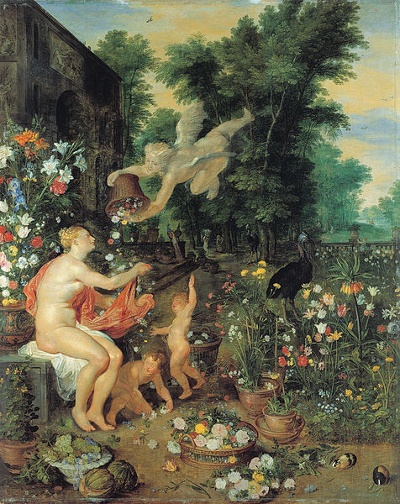John Keats, selected poems Contents
To Leigh Hunt: Imagery, symbolism and themes
Imagery and symbolism in To Leigh Hunt
 The sonnet itself is a symbol of Keats’ admiration of and gratitude to Leigh Hunt. It is an example of the ‘poor offerings’ that Keats feels are a ‘luxury’ to offer his mentor.
The sonnet itself is a symbol of Keats’ admiration of and gratitude to Leigh Hunt. It is an example of the ‘poor offerings’ that Keats feels are a ‘luxury’ to offer his mentor.
Keats’ delight in being able to write for Hunt is compared to the delights of the ancient world. This is captured in images of ‘incense’, ‘nymphs’, and the various offerings presented to the goddess Flora: baskets of corn, roses, pinks and violets.
Pleasure is particularly associated with the image of leafy trees.
The image of offering runs through the poem: the corn and the flowers offered by nymphs to Flora have their parallel in the poems which Keats offers to Hunt, his own tutelary spirit.
Investigating imagery and symbolism in To Leigh Hunt...
- In what sense is the sonnet itself a symbol?
- Why does Keats use so many images drawn from the world of classical mythology?
- What part does natural imagery play in the sonnet?
- What images of offering can you find in the poem – and what use does Keats make of them?
Themes of To Leigh Hunt
Keats’ main purpose is to express gratitude to, and admiration for, Leigh Hunt. The ideas are clear and uncluttered. The ‘glory and loveliness’ associated with the ancient, idyllic past have now vanished. However, there are some delights that remain – and chief amongst these is the opportunity for the poet to offer his writing - no matter how poor, Keats adds modestly – to such a man as Leigh Hunt.
The fact that Keats expresses admiration for a man at the centre of contemporary literary, social and political ideas by referring to the classical past is itself a tribute to Hunt’s erudition and cultural sensitivity. The world of classical culture may have disappeared in one sense but its images are still alive in the artistic imagination and its greatness now resides in the high ideals and lofty ideas of Hunt’s world.
Investigating themes in To Leigh Hunt...
- The sonnet’s purpose is clear: to express gratitude and admiration for his mentor. Do you think the poem has any other themes?
- In what sense are the classical references themselves at the thematic heart of the sonnet?
- If you knew nothing else about Keats apart from this poem, what could you discern about his values and preoccupations?
Recently Viewed
-
John Keats, selected poems » To Leigh Hunt: Imagery, symbolism and themes
now -
John Keats, selected poems » On First Looking Into Chapman’s Homer: Imagery, symbolism and themes
just now -
John Keats, selected poems » Hush, hush! tread softly! - Imagery, symbolism and themes
just now -
A-Z: General definitions » Pagan
just now -
John Keats, selected poems » When I have fears: Synopsis and Commentary
just now -
John Keats, selected poems » On the Sea: Synopsis and Commentary
just now -
John Keats, selected poems » Lines to Fanny: Synopsis and commentary
just now -
A-Z: General definitions » Evil
just now -
John Keats, selected poems » To My Brothers: Language, tone and structure
just now -
John Keats, selected poems » Ode to Melancholy: Language, tone and structure
just now -
John Keats, selected poems » Religious expression
just now -
John Keats, selected poems » On Seeing the Elgin Marbles: Synopsis and Commentary
just now -
John Keats, selected poems » Ode to Autumn: Synopsis and Commentary
just now -
John Keats, selected poems » Lamia: Synopsis and commentary
just now -
John Keats, selected poems » Early literary influences on Keats
just now -
John Keats, selected poems » Religious and philosophical context
just now -
John Keats, selected poems » Sleep and Poetry: Language, tone and structure
1 minute ago
